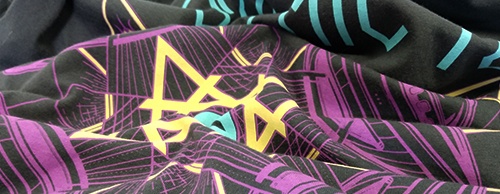

Printing soft-hand on dark garments is probably the single most challenging aspect of textile screen printing. The “hand” of a print is referring to the feel. The softer the hand of a print, the less you can feel it. There has been some really great improvements in the screen printing ink industry with ink additives and the onset of discharge printing. However, there is not a cut and dry solution for a bright print with a super-soft hand on dark garments.
The most successful soft-hand screen prints begin with the design. Usually the shirt color works with the art and is allowed to influence the print color. This allows the printer flexibility to use regular plastisol, soft-hand inks, or discharge depending on the complexity of the design and amount of detail.
A light blue print on a navy shirt is a good start to a soft hand product. On the other hand, white ink on red shirts will be very difficult to get a soft hand print.
Let’s look at the range of options and consider the variances in print quality.
PLASTISOL WITH UNDERBASE
This is the most traditional screen print method. You can expect the brightest print with the most amount of detail captured. The hand on this print will be the least soft.
PLASTISOL WITH NO UNDERBASE
Inks with more opacity can often be used with no underbase for a softer print, although it will not be as bright of a print. The shirt would likely influence the ink shade a little depending on the exact Pantone color printed. If you were printing yellow on royal, the shirt color would likely turn the ink a bit green. Tonal designs are great using this method and a lot of detail can be held with a pretty soft hand.
SOFT-HAND ADDITIVES
If you’ve been around the screen print industry for a bit, you’ve probably heard of some soft-hand additives - fashion soft, chino base, reducer - that can be mixed with a Pantone formula for a softer print. These inks have a hand comparable to water-based printing, but holds much more detail. These ink additives are only good for use on light garments though. When additives are added the ink loses opacity.
In most cases, when printed on dark garments, the shirt color will completely over-power the ink color. Because the inks are so transparent, they look washed out when printed on an underbase, and the underbase negates the softness of the reduced ink. Perhaps a soft-hand underbase could be used, but this would really depend on the design and the desired effect.
Here's an example of a soft hand print on a light garment. Bright color, great detail, super soft.
WATER-BASED
More and more people are requesting water-based printing. Water-based inks are even more transparent than plastisols with soft hand additive. Vast majority of inks won’t be visible on dark garments. Water-based white and a handful of the more opaque inks can be used on darks for a really vintage, faded look. Water-based inks don’t hold detail as well as plastisol and aren’t necessarily able to be an exact Pantone match. These are factors to consider when designing for a water-based print and/or inquiring about a print technique.
Here's an example of how water-based can work on a colored tee. There’s not a lot of detail in the design. The shirt color is a medium-light tone. The final product has a vintage feel, so the shirt color influencing the red ink is exactly the desired affect. The blue ink is darker than the shirt, so there is no adverse affect there.
DISCHARGE INK
Discharge ink was developed specifically for soft-hand printing on dark garments. Discharge is a water-based ink that bleaches the garment weave while depositing pigment. The look of the final print is quite different from traditional plastisol prints. The end print is more muted, the colors are flatter, and the edges of the screen stencil tend to soften through the production run. Butt-to-butt registration is not guaranteed. Discharge is really great for vintage looking prints with lose designs. Tight logo style graphics aren’t ideal for discharge printing.
Only 100% cotton garments have the potential to discharge. That being said, the exact discharge-ability of a particular tee is dependent on the conditions of the specific dye lot. A dye lot is the entire batch of shirts dyed at the same time. This is done in the t-shirt manufacturing process. There are a number of variables that can affect the quality discharge that varies from lot to lot. A black Hanes tee you print with discharge in June may not match a discharge print you do in July. Many times, t-shirt manufacturers will batch a bunch of overstock colors and dye them all black. Certain color shirts are more difficult to discharge. Reds, royals, cranberry, purples, and teal colors are all very difficult to get a consistent predictable discharge color.
In general, discharge is a very unpredictable process, that cannot hold a lot of detail. If you would like to screen print your custom design with discharge ink, be prepared to be super flexible with the results. Discharge printing can really be fantastic for certain designs, but the right designs are few and far between.
Here's an example of a design that works great with discharge ink. If you desire a soft hand print on your t-shirts, get your printer involved as soon as possible to discuss your options to achieve the closest desired affect as possible.

Leave a Reply
Your email address will remain private and will not be shared.